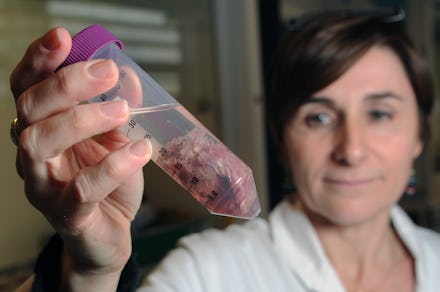Can lab-grown meat really save the planet?

Food and science are essentially inseparable. Harvesting crops and raising animals takes a knowledge of natural sciences and cooking and baking are of course complex and tasty versions of chemistry experiments.
As technology and cooking become ever more intertwined — anyone? — many of the basic ingredients humans have relied on for millenniums (meat, for example) are changing. With the threat of climate crisis and global water crises looming, lab-grown food may be the solution to food disasters long before they even happen.
In an October 2016 Wired piece entitled Nerds Over Cattle: How Food Technology Will Save the World, Bruce Friedrich, executive director of The Good Food Institute, postulates that lab-grown food and scientific innovation in the edible products we consume will seriously help humanity from food insecurity, especially with looming population growth. "We're not going to feed the world, and we're not going to avoid a climate catastrophe, if we continue our global reliance on a system of food production that is so vastly inefficient and polluting," Friedrich wrote.
Worldwatch Institute estimates that 54% of our annual global carbon emissions are caused by raising livestock and the related activities. That's a massive carbon footprint (hoof print?) related to eating animal products. Livestock is currently responsible for using over 8% of the world's water, an enormous amount considering that in less than a decade, 64% of the world is expected to live in "water-stressed basins" according to a recent report from the European Union. Most of this water is used as irrigation for crops that feed livestock, a seriously inefficient use of water.
How lab-grown meat could help
Instead of watering crops that are then fed to animals (who also require drinking water), lab-grown or "cultured" meat cuts out several steps by growing a meat-like substance more similar to raising plants than animals. As Friedrich points out in a Good Food Institute article, it would be accurate to call even more of our foods lab-grown, like processed cereals and peanut butter, which are all created in a lab before they're manufactured for our consumption. He actually prefers the term "clean meat" which he believes is the most accurate way to describe this manmade, slaughter-free meat product that may just save the planet.
In April 2008, PETA promised $1 million to the first person or organization who created meatless in vitro meat that would be available to consumers at a decent price by 2012. While no one met that goal, which sounded futuristic at the time (for reference, in 2008 George W. Bush was still president and Hillary Clinton was running against Barack Obama) the future was not far off.
While saving the environment is, of course, one political motive for supporting lab-grown meat, PETA's backing proves another major interest in the project: Animal welfare. Currently, beef cattle raised on factory farms undergo such injustices as branding, castration, horn removal without painkillers, overcrowding and force-feeding of grains that are foreign to the naturally grass-eating cow to plumpen them up for slaughter. While organic and all-natural farms may instill better animal welfare practices, the killing of animals, up until the advent of cultured meat, has always been necessary for humans to eat meat, a diet PETA certainly doesn't endorse.
The world's first lab-grown burger
The world's first lab-grown burger, created from cow cells and developed into muscle strips resembling actual beef, debuted in London in August 2013. Because actual animal cells are used to cultivate this lab-grown meat, the meat is legitimate meat, i.e. not suitable for vegetarians who do not eat animal products. The difference, however, is that this meat is not created by mass animal slaughter, but rather by extracting cells from a living cow and then scientifically manipulating those cells to create an edible meat similar to that which would come from cow flesh.
The $330,000 research project that resulted in the world's first lab-grown and certainly most expensive burger was just the start. Less than two years after the first burger tasting, the price of the world's first lab-grown burger officially dropped to around $11, the difference between buying a mansion or just opting to Supersize a familiar fast food menu, making the lab-grown meat, indeed, affordable.
Since, several biotech companies and universities have also joined the race to create lab-grown meat products, including New Harvest, which is developing animal-free eggs, milk and beef and Memphis Meats, which is developing cultured beef, pork and poultry. Growing meat in a lab uses a minimal amount of water and feed and therefore has the potential to massively cut down on carbon emissions as well as land and water use.
While these projects are expensive, the goal is to be able to scale these products to be affordable for consumers. Your next steak may be festering in a test tube or petri dish right now.